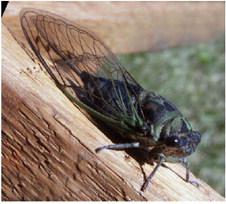UF-IFAS Osceola County Extension Services
Have you heard the buzz? Cicadas are insects known for their loud buzzing calls and fascinating life cycles, but they also play an important environmental role.
Cicadas spend most of their lives underground as young nymphs feeding on tree roots. Nymphs will molt four times underground. After two to 17 years, they dig their way to the surface. Nymphs then crawl to a tree trunk and cling there until they molt for a fifth time into winged adults, shedding their exoskeleton. Adults are active during daylight hours, during which males sing with a shrill buzzing noise to attract females. The intensity of their calls often rises and falls with temperature changes, creating a natural thermometer.
Florida has 19 species of cicadas. Some cicadas in America are “periodical” species with life cycles of either 13 or 17 years, however periodical cicadas are not found in Florida. Unlike the broods of periodical cicadas, populations of Florida cicadas produce adults every year. But their life cycles are still multiple-years long. Not much is known about how long these cicada nymphs stay underground—some species have two-year life cycles, but others have life cycles of 10 or more years.
Cicadas are not considered to be pests in Florida. Any damage they cause is negligible, so they don’t require treatment and are best left alone. They don’t bite, sting, or carry harmful diseases. In fact, cicadas play an important environmental role. As nymphs, they aerate the soil and help with nutrient cycling. They are also a vital food source for various wildlife including birds, reptiles, and mammals. Next time you hear the loud buzzing of cicadas, marvel at their interesting life cycle and environmental benefits.




